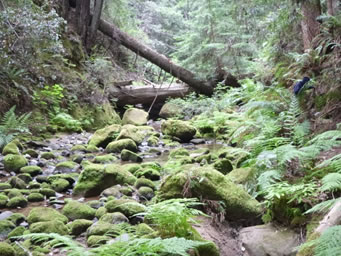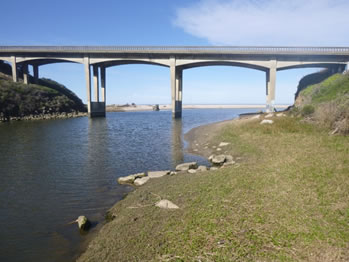San Gregorio Creek Sediment Water Quality Improvement Plan
Background
San Gregorio Creek is in western San Mateo County and drains a 52 square mile area from the Santa Cruz Mountains to the Pacific Ocean. It supports many beneficial uses including water supply, recreation and freshwater habitat for fish and other aquatic species. In 1998, the San Francisco Bay Regional Water Quality Control Board identified San Gregorio Creek as impaired due to excessive sedimentation under Section 303(d) of the Federal Clean Water Act. The 303(d) listing was made in response to concerns regarding adverse impacts to habitat for steelhead trout, coho salmon, and other threatened species whose populations have declined in recent decades. |
El Corte de Madera Creek in the San Gregorio Creek watershed |
| San Gregorio Creek is impaired by accelerated rates of erosion and sedimentation resulting from natural geologic and climatic processes augmented by human land use practices. Land uses that have contributed to the sediment impairment include historical logging and sawmills, road construction, poor grazing and agricultural practices, residential development, instream structures, and water diversions. | |
San Gregorio Creek at Highway 1 Bridge | These land uses contributed to one or more of the following effects: reach-scale channel incision, disconnection of the creek from its floodplain, reductions in large woody debris and channel complexity; reduced base flow in summer and fall; and, increases in fine sediment supply leading to deposition on the channel bed and filling of deep pools.
|
A Water Quality Improvement Plan (Plan) has been developed to restore water quality by improving sediment and habitat conditions in San Gregorio Creek. The Plan examines the water quality problem, identifies sources of sediment contamination, and specifies actions to improve water quality. This Plan relies on collaboration with stakeholders and builds on actions planned or being taken in the watershed to reduce sediment loads, and thus is likely achieve water quality objectives more quickly than a TMDL. The Plan identifies actions needed to address the sediment impairment, proposes implementation actions, and includes water quality monitoring to evaluate effectiveness of the corrective actions and assess attainment of water quality standards. If the Plan is successful, it will lead to removing the San Gregorio Creek sediment impairment from the Section 303(d) list. If the Plan is not successful, the next step would be development of a TMDL, which is a cleanup plan that is implemented through permits and orders the Water Board issues. |
Regional Water Board Approval ProcessThe San Francisco Bay Regional Water Board accepted the Water Quality Improvement Plan on October 12, 2021. Associated documents are available below: |
For more information contact: René Leclerc, P.E. San Francisco Bay Regional Water Quality Control Board 1515 Clay Street, Suite 1400 Oakland, CA 94612 Phone: 510-622-2410 Fax: 510-622-2460 E-mail: Rene.Leclerc@waterboards.ca.gov |




